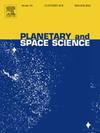了解土工性质对羽流表面相互作用对粘性侵蚀速率的影响
IF 1.7
4区 物理与天体物理
Q3 ASTRONOMY & ASTROPHYSICS
引用次数: 0
摘要
随着人类根据阿耳特弥斯计划重返月球,了解和减轻羽流表面相互作用(PSI)的影响对于保护月球上的人员和设备至关重要。为了帮助确定与粘性侵蚀和陨石坑形成相关的基本力学特性,我们在分流板和羽流陨石坑设置中使用压缩空气完成了使用碎屑模拟物和亚音速非反应流的实验测量。更具体地说,这些研究使用月球高地模拟物(LHS-1)、月球母马模拟物(LMS-1)、LHS-1D(尘埃)模拟物和大气中 40-80 μm 的玻璃珠,考察了体积密度、内聚力和排气流动特性对粘性侵蚀速率和陨石坑形成的潜在影响。结果表明,粒度分布最终会影响陨石坑的形状和侵蚀速率,这可能是由于内部摩擦角造成的。测量结果表明,增加体积密度,特别是从未压实状态到轻微压实状态,可使侵蚀率降低多达 50%。虽然颗粒材料的内聚力可在一定程度上降低侵蚀率,但由于颗粒结块,超过 1000 Pa 的较高内聚力实际上可能会增加粘性侵蚀率。本文介绍了 Metzger(2024a)体积侵蚀率方程的修正版,并讨论了其局限性。这些修改后的粘性侵蚀方程及其局限性表明,岩土特性在粘性侵蚀中起着重要作用,在未来任务规划的 PSI 计算机模型中应加以考虑。本文章由计算机程序翻译,如有差异,请以英文原文为准。
Understanding the effects of geotechnical properties on viscous erosion rate from plume surface interactions
With humans returning to the Moon under the Artemis program, understanding and mitigating effects from Plume Surface Interactions (PSI) will be essential for the protection of personnel and equipment on the Moon. To help characterize the underlying mechanics associated with viscous erosion and crater formation, experimental measurements using regolith simulants and subsonic, non-reacting flows were completed using compressed air in a splitter plate, plume cratering setup. More specifically, these investigations examined the underlying effects of bulk density, cohesion, and exhaust flow characteristics on viscous erosion rates and crater formation using Lunar highlands simulant (LHS-1), Lunar mare simulant (LMS-1), LHS-1D (Dust) simulants, and 40–80 μm glass beads in atmosphere. Results show that particle size distribution can ultimately influence crater shapes and erosion rates, likely owing to internal angle of friction. Measurements show that increasing bulk density, especially from an uncompacted to a slightly compacted state, decreases erosion rate by as much as 50 %. While cohesion of granular material can mitigate erosion rates to some extent, higher levels of cohesion above 1000 Pa may actually increase viscous erosion rates due to particle clumping. A modified version of Metzger's (2024a)equation for volumetric erosion rate is presented, with limitations discussed. These modified equations for viscous erosion, with limitations noted, show that geotechnical properties play an important role in viscous erosion and should be considered in PSI computer models for future mission planning.
求助全文
通过发布文献求助,成功后即可免费获取论文全文。
去求助
来源期刊

Planetary and Space Science
地学天文-天文与天体物理
CiteScore
5.40
自引率
4.20%
发文量
126
审稿时长
15 weeks
期刊介绍:
Planetary and Space Science publishes original articles as well as short communications (letters). Ground-based and space-borne instrumentation and laboratory simulation of solar system processes are included. The following fields of planetary and solar system research are covered:
• Celestial mechanics, including dynamical evolution of the solar system, gravitational captures and resonances, relativistic effects, tracking and dynamics
• Cosmochemistry and origin, including all aspects of the formation and initial physical and chemical evolution of the solar system
• Terrestrial planets and satellites, including the physics of the interiors, geology and morphology of the surfaces, tectonics, mineralogy and dating
• Outer planets and satellites, including formation and evolution, remote sensing at all wavelengths and in situ measurements
• Planetary atmospheres, including formation and evolution, circulation and meteorology, boundary layers, remote sensing and laboratory simulation
• Planetary magnetospheres and ionospheres, including origin of magnetic fields, magnetospheric plasma and radiation belts, and their interaction with the sun, the solar wind and satellites
• Small bodies, dust and rings, including asteroids, comets and zodiacal light and their interaction with the solar radiation and the solar wind
• Exobiology, including origin of life, detection of planetary ecosystems and pre-biological phenomena in the solar system and laboratory simulations
• Extrasolar systems, including the detection and/or the detectability of exoplanets and planetary systems, their formation and evolution, the physical and chemical properties of the exoplanets
• History of planetary and space research
 求助内容:
求助内容: 应助结果提醒方式:
应助结果提醒方式:


